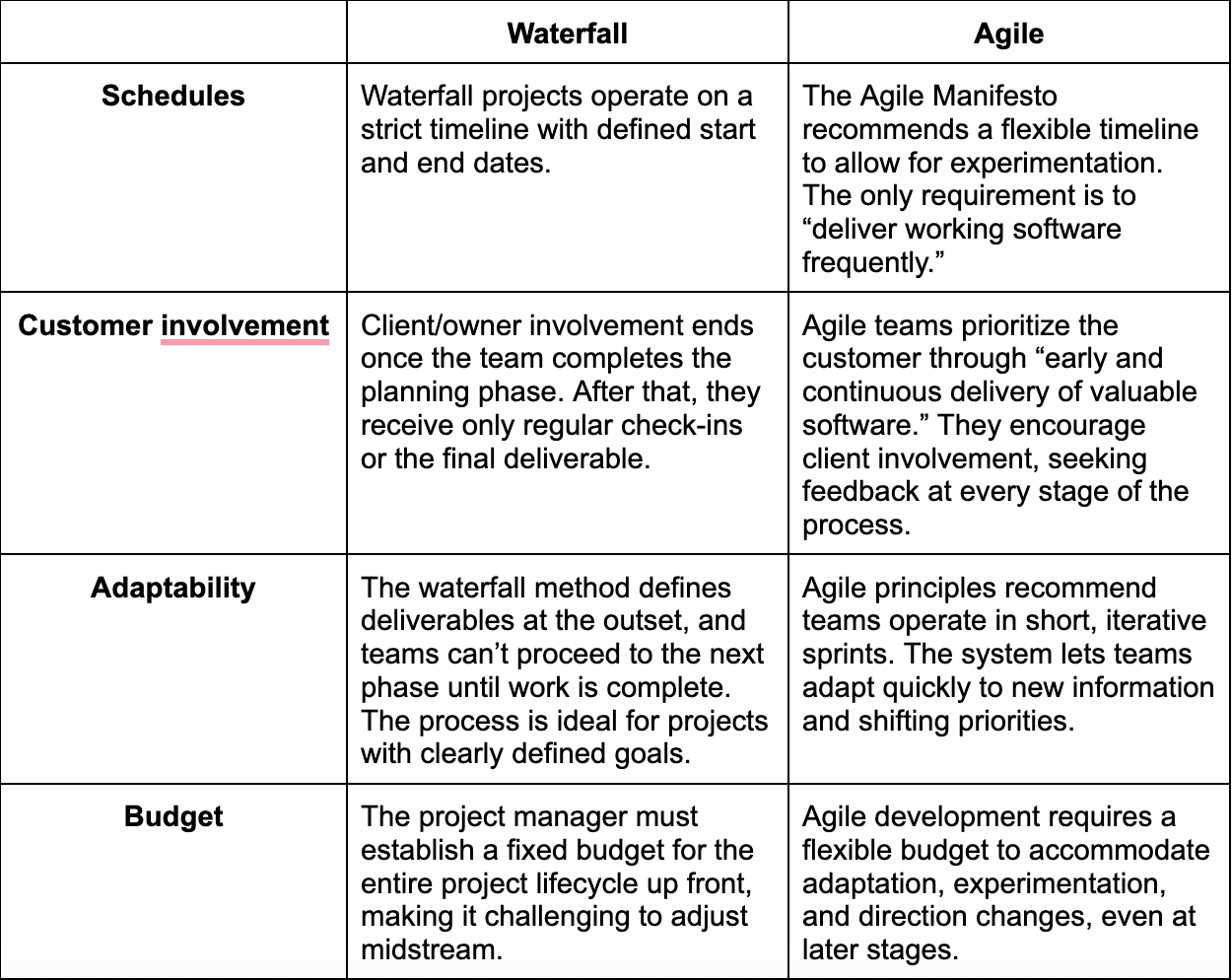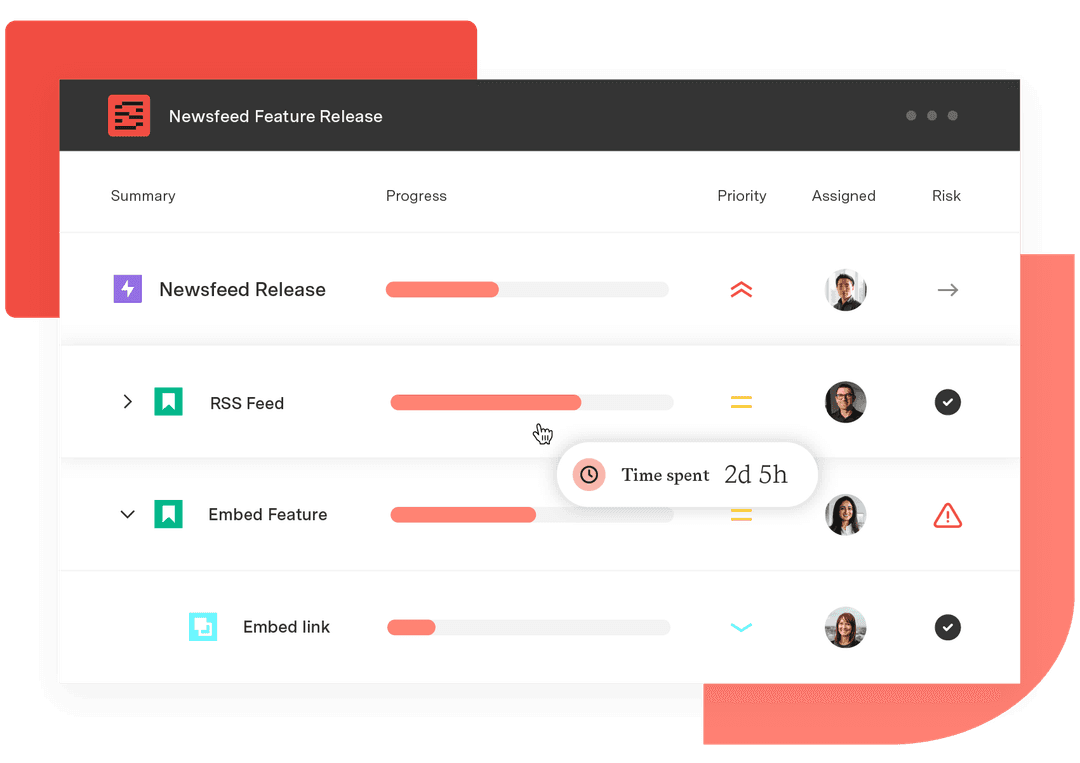Shaking up the status quo: Agile vs. waterfall approaches
Tempo Team
With the popularity of the agile project management methodology, it might seem like there’s no room for old-school approaches, such as the waterfall model. That couldn’t be further from the truth.
Although 71% of software development companies use agile management techniques like Kanban and Scrum to facilitate iterative development, there’s still a place for linear approaches, like the waterfall method.
The key to a successful outcome often depends on your project management methodology. Choosing the correct technique requires understanding the differences between waterfall versus agile and when you should implement one approach over the other.
What is agile methodology?
Software development project teams were the first to establish and embrace the agile model, which accounts for the fast pace of technological change and the protracted length of their projects. Developers needed a management methodology with the flexibility to accommodate shifts in direction throughout the software development life cycle (SLDC), even in its final stages.
The iterative and incremental nature of agile-based project development promotes adaptability, allowing teams to adjust requirements and outputs based on client and user input. Unlike a sequential development path, the Agile Manifesto prescribes a regular release cycle of product updates and new features, delivering successive quick wins and ongoing product improvements.
Teams that follow agile principles are self-directed, organizing their own work into phases with concurrent tasks and short-term deadlines. The arrangement empowers team members, increasing overall motivation and improving outcomes for stakeholders and the organization.
Pros of agile methodology
Thanks to the operational structure of the agile process, it offers many benefits to project teams, including:
Improved productivity and efficiency driven by short-term sprints and deadlines
Opportunities to detect and solve problems early on a fluid schedule
The flexibility to experiment with new project directions
Prioritization of high-value features
Cross-functional project teams with a shared skill set
A client-facing process that lets teams share progress and incorporate feedback
Improved relationships and connections
Faster time to market
Increased customer satisfaction
Cons of the agile methodology
Although the benefits of the agile approach are significant, there are substantial shortcomings to this development process:
Adjustments to early stages can impact later ones when working on multiple project phases simultaneously, increasing the probability of overlap and effort duplication
Alignment across teams and departments is difficult without concrete deliverables
Increased risk of miscommunication
Project timelines are difficult to calculate and susceptible to change
Poorly defined critical path and inter-project dependencies
Significant organizational learning curve
Agile’s continuous iteration pipeline involves significant engineering costs and technical dependencies
What is waterfall methodology?
Waterfall project management follows linear, sequential task execution within five defined project phases:
Initiation
Project planning
Execution
Monitoring/control
Closing
Team members must finish each development stage and gain approval before moving to the next. A change in scope or missed deadline causes a ripple effect impacting future phases.
The waterfall model’s limitations mean it requires meticulous project planning. The scope must be clearly outlined, the dependencies mapped, and the schedule padded to accommodate any risks or challenges. The project manager takes the lead, ensuring effective time management and overseeing a change control process to minimize scope creep.
The rigidity of the waterfall methodology makes it difficult and expensive to revisit a previous project stage. Its inflexible schedule and resource allocation prevent the team from switching gears in the face of unforeseen developments. This could leave the project susceptible to technical debt or cause the product to lose market share.
Pros of waterfall methodology
Despite its shortcomings, the waterfall project management methodology can prove useful. Under specific circumstances, the model offers some significant advantages over the agile method:
Yields a concrete project plan with clearly defined dependencies throughout
Saves the project manager’s time by outlining project requirements at the start
Project phases divided into concrete deliverables require less hands-on coordination
Allows for more accurate cost estimates
Increases focus on design and requirement documentation
Institutes a structured design phase before software development begins
Cons of waterfall methodology
Along with the lack of adaptability, the waterfall development methodology has additional drawbacks:
Project delivery takes longer due to the sequential development lifecycle
Teams require additional communication overhead during phase transitions
Strict phase sequences make dividing and sharing work between teams difficult
The lack of feedback may delay the discovery of a mistake until the team progresses to the next development phase, obscuring where and when the error occurred
Delayed transition to the next phase can waste time and set back deliverables
Lower cross-functionality necessitates additional staff to fill the skill gap
Focus on the current phase rather than the complete package reduces team ownership and engagement
Agile vs. waterfall: Primary differences
The decision to work as a waterfall or agile team carries significant implications for your project and customers. Here’s a side-by-side comparison:

Waterfall or agile: What’s right for you?
Agile’s fast-moving iterations, user stories, and increased flexibility might be attractive, but is it the right choice for your team? Or would you benefit from a highly structured, linear process that maps the entire process ahead of time?
Those are tough questions. You must review the project’s characteristics to see whether it demands the waterfall or the agile methodology.
Waterfall projects
Waterfall management suits well-defined, straightforward projects with established requirements and an explicit timeline. The waterfall model works best for projects with these traits:
Simple scope and requirement gathering
Accommodate a linear sequence
Predictable results
Structured workflow and process
Rigorous quality control
Long-term commitment
Agile projects
The agile project management model supports initiatives with abstract outcomes and those requiring numerous feedback loops.
Agile software development is particularly effective because it permits iterations and frequent testing as the team moves forward. It’s also a helpful methodology when working with dispersed teams requiring intense collaboration.
Consider an agile method when your project meets the following criteria:
Complex deliverables
Regular iterations and refinement
Short turn-around time on deliverables
Emerging product requirements
Collaborative effort
Numerous stakeholders
Conclusion
No matter the project management methodology, you need the right tools for the job. Jira project management software is the go-to application for most agile teams, allowing scrum masters to create Kanban boards, manage backlogs, and organize sprints. But this doesn’t mean you’re left out in the cold if you favor the waterfall approach.
Tempo's Structure PPM, a portfolio management application, integrates into Jira so you can organize projects using a linear structure similar to the waterfall methodology you’re familiar with.
You can leverage other Jira-enabled Tempo applications, such as Strategic Roadmaps and Timesheets, whether operating under agile or waterfall. The Strategic Roadmaps application simplifies project planning by generating intuitive project road maps that help teams identify critical paths, task dependencies, and roadblocks. Tempo Timesheets facilitates time and resource use monitoring, so you’re always on track to meet your goals and objectives.
Whatever your project management tool requirements, Tempo has the solution.
Sign up for a demo
Register













































